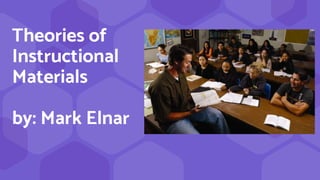
Theories of instructional materials
- 2. Objectives a. To enumerate the theories of Instructional Materials b. Discuss the theories of Instructional Materials c. Appreciate the importance of using Instructional Materials in our lives 2
- 3. 3
- 5. Instructional Materials ⬢ Instructional materials refer to the human and non-human materials and facilities that can be used to ease, encourage, improved and promote teaching and learning activities. They are whatever materials used in the process of instruction. 5
- 7. The systematic development of instructional specifications using learning and instructional theory to ensure the quality of education. It is the systematic and reflective process of translating principles of learning and instruction into plans for instructional materials, activities, information resources, and evaluation. Instructional Design Theory 7
- 8. 5 Examples of Instructional Design Models 8 1.Bloom’s Taxonomy: Bloom’s Taxonomy is “a hierarchical ordering of cognitive skills that can help teachers teach and students learn.” Bloom’s Taxonomy has six levels: remember, understa apply, analyze, evaluate, create. 2. ADDIE Model: Arguably the most important instructional design model, ADDIE — analysis, design, development, implementation and evaluation — is used as a process guide when developing effective training tools. 3. Iterative Design: Iterative design calls for “incrementally developing and refining a design ba on feedback and evaluation.” Additional instructional design models have been spun out of itera design including Rapid Prototyping and the Spiral Model.
- 9. 9 4. SAM Model: SAM is short for Successive Approximation Model, and is a simplified version of the ADDIE Model. Where the SAM Model differs is that feedback is collected earlier so designers can build working models earlier in the process. Where ADDIE processes are quite linear, SAM is a recursive process. 5. Learning Circle Framework: The Learning Circle Framework is an instructional design model that works in three phases: target, create and launch.
- 10. Behaviorist Theory ⬢ The hallmark of this theory is that one does not have to delve into the invisible workings of the mind to understand learning ⬢ Behaviorists believe human beings are shaped entirely by their external environment. ... 10
- 11. 11 An example of behaviorism is when teachers reward their class or certain students with a party or special treat at the end of the week for good behavior throughout the week. The same concept is used with punishments.
- 12. Cognitive Theory ⬢ Interest of their perception of forms, shapes and procedures Cognitive Learning Theory explains how we process information when we learn. ... This type of teaching and learning, where the learner is mostly passive, sitting down and listening, while the active participant – the teacher – imparts their knowledge is linked to the Behaviorist Learning Theory. 12
- 13. 13 As one grows up, you become an active participant in different processes through which you gain new knowledge and skills. Training of cognitive learning to employees in organizations enhances and strengthens their expertise in handling more complex tasks.
- 14. Cybernetic Theory ⬢ These theory rely on error detection and error correction and provided a model for a different view of learning. ⬢ The cybernetic principles of learning are drawn from the implications of applying to learning the insights into the behavior of living systems provided by the study of cybernetics. Cybernetics is underpinned by the notion of circularity and feedback between a system and its environment. 14
- 15. ⬢ Cybernetics is the discipline that studies communication and control in living beings and in the machines built by humans. ⬢ It is also a theory of communication and control of regulatory feedback 15
- 16. Humanist Theory ⬢ More concerned with education’s role in the development of the person as a person ⬢ This system stresses that human beings are inherently good, and that basic needs are vital to human behaviors. Humanistic psychology also focuses on finding rational ways to solve these human problems. 16
- 17. 17 This theory and approach in education takes root in humanistic psychology, with the key concepts focusing on the idea that children are good at the core and that education should focus on rational ways to teach the “whole” child. This theory states that the student is the authority on how they learn, and that all of their needs should be met in order for them to learn well. For example, a student who is hungry won’t have as much attention to give to learning. So schools offer meals to students so that need is met, and they can focus on education.
- 18. Social/Situated Learning Theory ⬢ Emphasizes the importance of observing and modeling the behaviors, attitudes, emotional reactions of others ⬢ Situated learning theory states that every idea and human action is a generalization, adapted to the ongoing environment; it is founded on the belief that what people learn, see, and do is situated in their role as a member of a community 18
- 19. 19 Learners achieved a gradual acquisition of knowledge and skills and moved from being novices to experts. Such learning is contrasted with classroom learning that often involves abstract and out-of-context knowledge. Situated learning was observed among Yucatec midwives, native tailors, navy quartermasters, and meat cutters (Lave and Wenger, 1991).
- 20. Why is IM important? ⬢ Instructional materials are essential since they help the teacher and learners avoid overemphasis on recitation and rote learning that can easily dominate a lesson. Resource materials allow learners to have practical experiences which help them to develop skills and concepts and to work in a variety of ways. 20
- 21. 21